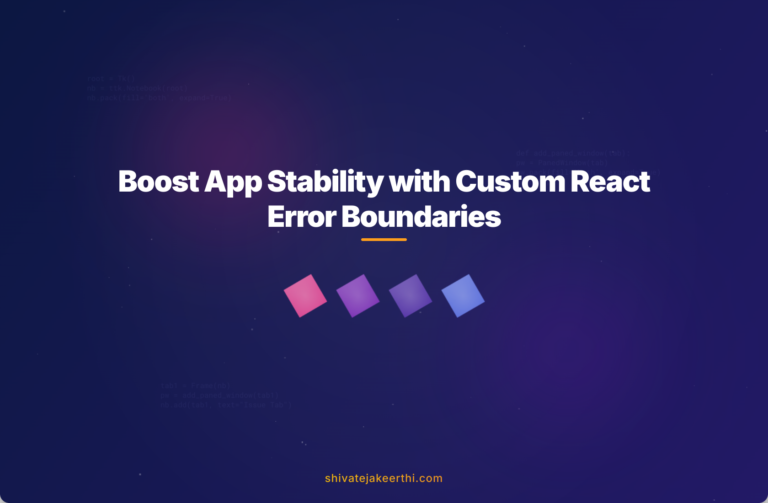Error boundaries in React serve as safety nets for your components, guarding your application against unexpected runtime crashes. Think of them as React’s built-in error handlers—they catch JavaScript errors anywhere in their child component tree, display a fallback UI, and prevent your entire app from crashing.
They are particularly useful in production scenarios where stability and user experience matter significantly. Typically, you might implement them at higher component levels, acting as sensors for errors bubbling up from different parts of your application.
What Happens When React Error Boundaries Fail to Provide Helpful Feedback?
But what happens when these React error boundaries replace your entire user interface due to an error in just a small part of your app? Imagine a scenario where just a single button click or minor component error results in a blank screen or an intimidating error message for your users.
This scenario can degrade your app’s user experience drastically. Users encountering a blank screen or completely altered interface may think the app has broken down entirely and might decide not to revisit your application.
The core issue here lies within React’s default behavior of replacing an error-affected UI entirely with the fallback component defined within an error boundary. Often, developers use generic fallback screens, inadvertently causing large parts of the app UI to disappear.
The Ideal Outcome: Maintaining the UI While Notifying Users of Issues
The ideal approach to managing errors in React apps would be different. Instead of replacing the entire component tree, your error boundaries should ideally:
- Maintain as much of the original UI intact as possible.
- Provide users with clear feedback through alerts or popups rather than replacing large UI sections.
- Ensure users can continue using unaffected parts of the app.
To achieve this, developers must create a fine-grained strategy for error handling—one that notifies users about specific problems without negatively impacting their overall experience.
Analyzing the Limitations of Default React Error Boundary Behavior
To find a solution, consider the default behavior of React error boundaries. React errors trigger the lifecycle methods getDerivedStateFromError or componentDidCatch. These lifecycle methods help your components understand that an error has occurred and activate a fallback UI immediately.
Consider a simplistic example of a typical error boundary:
import React from 'react';
class ErrorBoundary extends React.Component {
constructor(props) {
super(props);
this.state = { hasError: false };
}
static getDerivedStateFromError(error) {
return { hasError: true };
}
componentDidCatch(error, info) {
console.error('Error caught:', error, info);
}
render() {
if (this.state.hasError) {
return <div>Something went wrong.</div>;
}
return this.props.children;
}
}
export default ErrorBoundary;
Here, the entire UI subtree under the error boundary gets replaced when hasError becomes true. This means even minor errors cause a significant change to your rendered UI.
An Alternative: Custom Error Handling and User-Friendly Notifications
The solution lies in custom error boundary handling, tailored specifically to avoid replacing larger sections of your app. This involves a more refined conditional rendering strategy to notify users via popup alerts or subtle inline error indicators rather than replacing entire components.
Designing a Custom Error Boundary
Consider modifying your error boundary component to use less invasive methods for notifying users. Here’s an improved error boundary that maintains UI visibility:
import React from 'react';
class AlertErrorBoundary extends React.Component {
componentDidCatch(error, info) {
console.error('Error Caught:', error, info);
// Show an alert or notification
alert('Oops! Something went wrong. Please refresh or try again.');
}
render() {
return this.props.children;
}
}
export default AlertErrorBoundary;
This approach doesn’t involve changing the state or rendering alternative fallback components. Instead, it simply catches the error and notifies users through an alert, keeping your whole UI visible.
Conditional Rendering within Components
Additionally, you can use conditional rendering within individual components to check the presence of required props or state. For example:
function UserProfile({ user }) {
if (!user) {
console.warn('User data is missing.');
return <div>User data unavailable.</div>;
}
return (
<div>
<h3>{user.name}</h3>
<p>{user.email}</p>
</div>
);
}
By handling the error situations closely at component level, you avoid activating error boundaries unnecessarily, maintaining your app’s visual continuity.
For deeper insights into React conditional rendering techniques and best practices, check this article on advanced JavaScript concepts.
Testing Your Custom Error Handling Solutions
Once you’ve developed a custom error handling strategy, thorough testing is crucial. Set up a robust testing environment using tools like Jest and React Testing Library.
You should simulate common JavaScript errors—such as null reference exceptions, undefined methods, or data inconsistencies—to ensure your custom error handling works correctly. Debug any problematic interactions between components, and refine your strategy continually through testing feedback.
Best Practices for Effective Error Handling in React Applications
Effective error handling is vital to React application stability and user satisfaction. Here are actionable tips every developer should follow:
- Scope Error Boundaries Strategically: Place error boundaries selectively around components, rather than at only the highest application levels.
- Keep UI Intact: Prefer to use visual indicators (tooltips, toast notifications, alerts) instead of UI replacement wherever possible.
- Developer-Friendly Error Messages: Log detailed errors to your console or error monitoring services (like Sentry) for better debugging.
- User-Friendly Notifications: Notify users in unobtrusive ways, helping them understand what happened and how to proceed.
Following these will drastically enhance your application’s resilience and user satisfaction.
Final Thoughts: Taking Control of Error Management
React error boundaries, when used incorrectly, can negatively impact user experiences by blanking out large pieces of your interface. Developing custom solutions that notify rather than replace makes your apps robust, reliable, and enjoyable for end-users.
Incorporate these suggestions into your React development practices. Always strive for clear, helpful communication with your users, even during unavoidable errors.
Feeling inspired to improve your React apps? Why not take a moment to audit your existing applications for these common UI replacement issues today? Let’s make the web robust, user-friendly, and resilient—one app at a time!



0 Comments